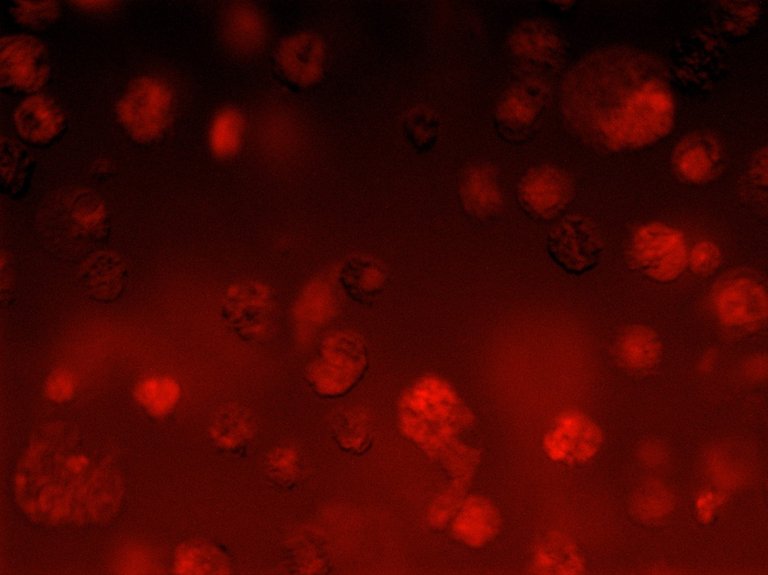HL-60 leukemia cells labeled with red (orange) fluorescent protein tag

I have been working with HL-60 leukemia cells for about a year now. I successfully transfected this cell line to express a red (orange) fluorescently labeled protein. I am currently studying how human immune cells respond to fungal particles invitro. We are specifically interested in Candida albicans infection in the blood. Fungal sepsis has a very high mortality rate.
HL-60 cells originally came from a patient with acute promyelocytic leukemia. This cell line grows as a suspension culture and used only in laboratory research. I believe the cell line was first established in the late 1970s. The first vial of cells I thawed were frozen and stored in LN2 since 2002. I now have my own collection of frozen HL-60 cells for future research stored away in the LN2 Dewar.
The reason I chose this particular cell line is because they can be induced to differentiate into neutrophil-like cells. Neutrophils are one of the immune cells that we study for sepsis. These cells are among the first to arrive at the site of an infection. They help signal the immune system to attack anything foreign. We discovered in our research that sepsis patients have an increased expression or upregulation of a particular protein on the cell surface of their neutrophils. This protein recognizes fungal elements.
The picture above is the successful transfection of HL-60 cells to overexpress this protein of interest with a tag so that we can visualize it under a fluorescent microscope. The cells were in media containing phenol red. There is some autofluorescence from the media making the background red. However, you can clearly see the surface of the cells with a bright red fluorescence in the 604nm channel. These are my preliminary findings.
It has been challenging to keep the cells alive after transfection. I recently switched to a high glucose growth media. I am also trying a new transfection method alongside the original method. I will be repeating the experiment again this week. This time, I will fix the cells on a slide so there is no autofluorescence. Once I have successfully transfected these cells again, I will induce them to differentiate and perform the same experiments that I have run on healthy human neutrophils and sepsis patient neutrophils. Eureka!
Interesting stuff! Amazing that this cell line is being involved invitro for over 50 years. What will be the goal of comparing the transfected HL-60s with healthy human and sepsis patient neutrophils?
Great question! Comparing the results from previous experiments with healthy donors and sepsis patients to the new experiments with the HL-60s may help prove that the upregulation of this protein affects immune function in some way. It's more of a proof of concept that this protein is increased during sepsis.
This protein may serve as an indicator or biomarker for sepsis. We're talking years into the future here, but imagine a test with one drop of blood from the tip of one's finger onto an test strip that would tell a physician within seconds that a patient is septic. Cool huh?
Here's a very interesting article from 2019 describing another way that scientists are trying to beat the clock against sepsis and septic shock. https://www.bbc.com/news/uk-wales-49677463
This made me feel like an idiot child and I'm delighted!
But I don't know what to add or any questions to ask. Like, seriously. I'd need a week on dictionary.com or whatever just to know exactly that I may never fully understand what you said. I liked the Eureka part, though... it made me feel like there was a happy ending.
I do really appreciate the visual assist, though. It kept me anchored enough to follow the flow of what you were saying...
And just to prove my opening statement...
You once told me they love sugar, hence the choice of media,I presume, but we love sugars, too, and they kill us. Are organisms so small able to physiologically differentiate between good food and bad food or is anything they eat that doesn't hurt them just food?
Not all sugars are bad for us. Too much of anything can be detrimental. Glucose is just food for cancer cells. They grow rapidly in the presence of high glucose. This is why someone with cancer should consider reducing or eliminating certain sugars from their diet.
I first tried using a common media for suspension cells but had a difficult time keeping the HL-60s alive after transfection which involves electroporation. Yes, you heard that right. I basically electrocute the cells to create pores so a plasmid can enter the cell membrane. The plasmid contains the code for the protein of interest along with the code for the fluorescent tag.
The cells are growing so much better in the high glucose media. I'm hoping this will help them survive the electroporation or other transfection methods and grow so that I can actually experiment with them.
In their defense, I think you'd have a hard time keeping me alive after electrocution, too, no matter how much ice cream you give me, so they sound like little troopers. No wonder they're so hard to cure.
Congratulations @melyxaluna! You have completed the following achievement on the Hive blockchain and have been rewarded with new badge(s):
Your next target is to reach 50 upvotes.
You can view your badges on your board and compare yourself to others in the Ranking
If you no longer want to receive notifications, reply to this comment with the word
STOPCheck out the last post from @hivebuzz:
Support the HiveBuzz project. Vote for our proposal!